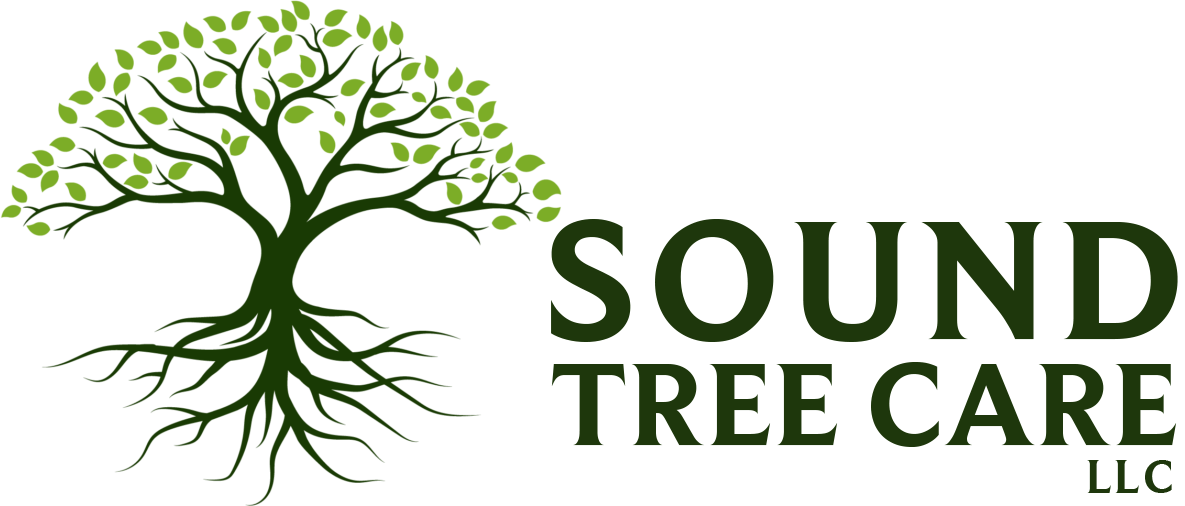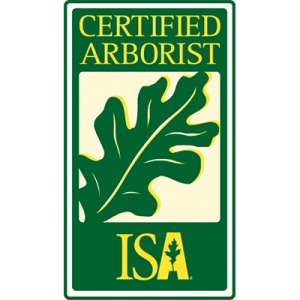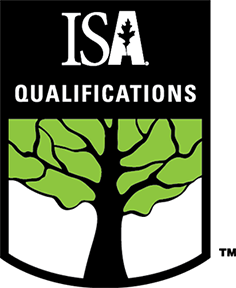Trimming Vs. Pruning: What's The Difference?
Written By: Eric Ledford
ISA Certified Arborist – PN-9290A
ISA Qualified Tree Risk Assessor (TRAQ)
Expert Guide To Tree Pruning and Trimming

While you often see the terms pruning and trimming used interchangeably, when it comes to arboriculture, they are very different. In this article, we will explore the differences between tree pruning and trimming and answer commonly asked questions about pruning and trimming trees, hedges, and other woody landscaping.
What's The Difference Between Pruning And Trimming?
What Is Pruning?
Pruning in arboriculture is practiced to improve and preserve the health of your trees. Pruning is done to remove dead, dying, damaged, diseased, rubbing, or crossing branches, thin out the canopy, remove suckers and water spouts and remove stems to improve your tree’s structural integrity and encourage healthy growth.
Pruning is done when the tree is dormant during late fall to early spring. You can also prune to just above a bud on flowering trees and shrubs after their blooms are spent. However, you can safely remove damaged and broken branches whenever you see them, so long as you do it correctly.
What Is Trimming?
Unlike pruning, trimming is typically done for aesthetics rather than health reasons. You can safely trim trees more frequently than prune them, even during growing seasons on many tree species.
For example, cutting branches of your hedge, shrubs, or trees to shape them and create a polished, uniform appearance would fall under trimming.
Do I need to prune and trim my trees?
Pruning and trimming are vital aspects of good tree care and maintenance. Regular trimming and pruning:
- Encourages healthy growth
- Improves leaf, flower, and fruit production
- Helps maintain the structural integrity of your trees by eliminating sail branches and other overgrowths that puts your plants at risk for windthrow and damage during storms
- Helps prevent the spread of harmful insects and diseases
- Ensures the structural integrity of your trees as they grow
- Keeps your landscape looking attractive and well-groomed
- Enables you to detect and address issues before they become severe
When should you trim your trees?
While tree trimming can be carried out more frequently than pruning, it's best to avoid trimming or pruning your trees in the late fall. Pruning and trimming encourage new growth, so cutting branches too close to dormancy periods can cause more harm than good.
Pro Tip: Identifying dead branches and altering growth direction and shape is easier after your trees fully bloom and the leaves fully develop.
Every tree species has different growth patterns and needs, so research before trimming your trees.
If you need help identifying the types of plants you have and how to trim them properly, contact your local nursery, speak to an arborist, or call a tree service near you for guidance.
When should I prune my trees?
Prune your trees when they are dormant, during late winter and early spring in Seattle. Whether you need to prune annually or less often depends on the tree's age and growth pattern. Slower growing and evergreen trees need less frequent pruning.
Cutting away branches to encourage healthy growth during dormancy (when your trees are not growing):
- Allows the tree to put its energy into healing the wounds without sacrificing growth
- Prevents insects and diseases from entering through the cuts because pests and spores are also dormant at this time
- Makes it easier to see the branch structure of your trees, identify problem branches (heavy, crossing, rubbing, diseased, broken, or dying), and cut them above the buds or nodes without damaging new growth, leaves, or flowers.
- Enables you to safely remove suckers and waterspouts from the base of your tree.
How To Prune and Trim Trees
Pruning Techniques
Prune side branches back to the main stem or trunk following the
Rule of Thirds (never prune more than 1/3 of the tree’s canopy in a given year).
Leave the collar
(base of the branch that resembles a raised ring) intact. The collar must be undisturbed for the wound to heal properly.
Cut at a
45-degree angle ensuring the lowest point does not go below a bud or node.
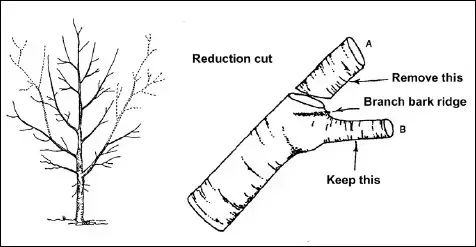
How to correctly prune branches. Image courtesy of
Almanac.
For larger branches, cut back to just above where a smaller stem emerges from the branch you are pruning (lateral branch). For smaller branches, cut back to an outward-facing bud.
When cutting branches over 1-1/2 inches in diameter, use a pruning saw or bow saw to make a
3-part cut:
1. Make the first cut from underneath about 6 to 12 inches from the trunk. Cut about 1/3 of the way through the branch.
2. Next, cut 3 inches away from the first cut towards the end of the branch. As you are making the cut, the branch will fall, so you may need to
support it to prevent tearing.
3. Finally, the remaining stem back to the branch collar.
DO NOT apply wound sealer to the cut; it only slows healing, promotes decay, and leaves your tree vulnerable to disease.
Trimming Techniques
The same cutting techniques apply to trimming and shaping your trees,
hedges, and shrubs that you use when pruning.
Always cut at a
45-degree angle and never below a bud or into the collar of a branch.
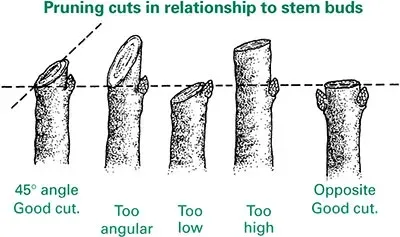
How to trim stems. Image courtesy of Almanac.
When trimming a hedge, use guides and cut using sweeping upward motions. Remove inner branches to thin out the center to promote light penetration and airflow. Cut the sides at an angle so the base is wider than the top.
For tips on hedge trimming, read Hedge Trimming: You Asked We Answered.
Can I prune or trim too much?
You can prune or trim your tree too much. Removing more than 1/3 of your tree’s canopy (tree topping or heading) in a given year can kill your trees. For young and newly planted trees, do not remove more than 25% of their canopy in a year. The canopy is where the majority of growth happens. Removing it stops growth, weakens your tree, and leaves it vulnerable to insects, windthrow, and disease.
Do I prune mature trees differently than young trees?
Mature trees can handle more aggressive pruning than young and newly planted trees. While you can prune up to
1/3 of the canopy on a mature tree in a given year, you should
never remove more than 25% of a young tree’s branches during a pruning season.
When pruning young trees, you aim to ensure it develops a robust root system and structure. You will remove branches to prevent trunk splitting and sail branch growth while encouraging the development of a healthy, uniform canopy.
Read
How To Prune Young Trees For Structure And Form for more tips on pruning young trees.
When pruning mature trees, you focus on maintaining their shape, structural integrity and improving leaf, flower, and fruit production.
How do I prune and trim fruit and flowering trees?
Fruit-producing and flowering trees require pruning to encourage blossoming and quality fruit production. While you can trim many tree species throughout the growing season, you should avoid trimming away dead branches until after flowering trees have finished blooming.
It is safe to cut away dead, dying, broken, damaged, and diseased branches during dormancy.
PRO TIP: Some flowering trees produce new growth and blossoms from dead wood. We recommend consulting with a local arborist or tree service with extensive knowledge of pruning and trimming flowering trees and shrubs before getting out the shears.
What about pruning and
trimming hedges? Is there a wrong way to do it?
Like other trees and shrubs, hedges should be pruned during dormant periods. How to correctly prune and trim your hedge depends on whether it’s for privacy or ornamental purposes and what type of plants make up your hedge. Different trees have different growth rates and maintenance needs.
For example, evergreen hedges require little to no pruning, while deciduous trees and mixed hedges require pruning every few years and regular trimming to promote the desired growth and keep their shape. Flowering hedges require more specialized care.
While hedge-trimming techniques are straightforward, knowing when and how to prune them correctly requires the right tools, knowledge, and experience.
You can over-prune your hedge, which leads to premature death. Pruning so the top is wider than the base prevents sunlight and moisture from reaching the bottom branches, resulting in a lush green hedge at the top and a thin, dead base.
To ensure your hedges get the maintenance they need, hire a professional.
What if my tree is near utility lines or very close to my house?
If your tree is near utility lines or very close to your house or other structures,
have a professional take care of the pruning and trimming. Falling branches and debris can damage nearby structures or fall on power lines. Local arborists and tree care companies have the tools and skills to groom trees in any location safely.
PRO TIP:
If you need to trim or prune trees near utilities, in alleys, or the right-of-way, the city will cut them for free. They may not make them look pretty, but they get the job done.
Can I trim and prune the parts of the tree that are on my neighbor’s property?
If the tree trunk is on your property, you are responsible for pruning, trimming, and caring for your tree. You can remove or trim overhanging branches beyond your property line without violating trespassing laws.
If you need to prune or trim a tree that overhangs your neighbor’s property, contact them and come to an agreement on how best to approach it. If you plan to hire a professional service, notify them so your neighbor knows what to expect and when.
Open communication can alleviate conflict and stress when caring for trees that grow on your and your neighbor’s property. To learn more about where the responsibility for shared trees lies, read our blogpost regarding
timber trespass.
What if my tree is infested with insects?
If you suspect your tree is infested with insects, contact your city or a local arborist before attempting to trim or prune it. They can help you identify what type of pests are damaging your tree- invasive or native - and take appropriate measures to contain and control them.
For information about Washington invasive pests and what to do if you see them on your trees, go to
https://invasivespecies.wa.gov/.
What if I see fungus or strange growths on my tree? Can I cut them off?
If you see fungus or other odd growths on the trunk or branches of your tree, contact a certified arborist or tree service near you. They can determine the safest, most effective course of action and whether removal is necessary.
Do not attempt to cut off or disturb the fungus. Doing so will cause it to release spores into the air and spread to other trees and plants.
For information about tree diseases common in Seattle, read
Common Tree Diseases To Watch Out For In Your Seattle Trees or visit
https://www.seattle.gov/trees/tree-pests/disease-pests.
What if my tree trunk looks rotten? Should I cut it down?
Contact a tree care company near you if your tree stem looks rotten. An arborist will assess your tree and determine whether they need to remove it. Regardless of the size of the tree, you need a permit to remove it in Seattle, Washington, and other states.
Exceptional trees require arborist assessments and must be removed by a registered tree care company in Seattle. To learn more about Washington regulations around tree removal and pruning, talk to a local arborist or visit
https://www.seattle.gov/sdci/permits/permits-we-issue-(a-z)/tree-removal.
How do I remove large branches?
Apply the
3-Part Rule
when removing large branches. Use a saw and have someone help you to ensure the branch is supported to prevent tearing or damage when it falls. We recommend having a professional remove large branches that cannot be safely removed from the ground or if the tree is close to structures, utilities, or public spaces.
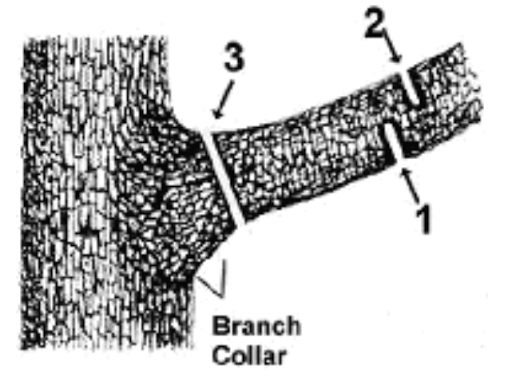
IMPORTANT: You may need a permit to remove large branches. Failing to do so could result in penalties and fines. Talk to a local tree service before proceeding.
Should I hire a professional to trim or prune my trees?
Although the techniques and principles of pruning and trimming are simple, understanding the needs of different trees and shrubs and what to do to achieve the desired results while preserving the structural integrity of your woody landscaping requires extensive knowledge.
To ensure your trees thrive and you achieve your landscaping goals, we recommend hiring a professional to trim and prune your trees.
A professional tree service pruning your trees saves you time, energy, and risk of harming your trees, property, or injury while ensuring your trees receive the best care. They can identify, treat, and prevent disease and infestations, provide remediation, and teach you how to maintain your trees.
To explore more expert tips and insights, visit our blog today! 7 Reasons to Hire a LIcensed Tree Service.
How much does it cost to have a tree service prune or trim my trees?
The cost to have an arborist or tree service prune and trim your trees depends on their size, condition, how many trees you have, and what you want to achieve. Most reputable tree care companies offer free estimates for all their services.
As a respected tree service in Seattle, we provide free consultations and estimates to determine how much it will cost to prune your trees. Learn more about the importance of professional tree trimming by reading our blog post:
Cost of Tree Trimming.
Pruning Maintains The Health Of Your Trees While Trimming Maintains Their Aesthetic Appeal
While the techniques used to remove branches are the same, whether you prune or trim your trees depends on the purpose. Pruning preserves and protects the health and integrity of your trees, hedges, and shrubs, while trimming is carried out to maintain the tree’s shape and aesthetic appeal.
After reading this article, you know when and how to prune or trim your trees confidently.
Contact us if you have any questions or concerns or need help maintaining your trees. We are a registered tree service provider operated by a certified arborist servicing Seattle, SeaTac, Burien, and the Puget Sound area with premium quality tree care, including tree removal, trimming, pruning, health care, consultations, fire remediation, and land clearing.
If you have trees, you need Sound Tree Care.
